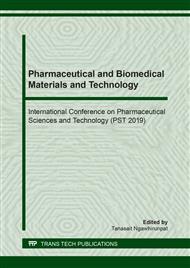p.157
p.163
p.169
p.175
p.181
p.187
p.195
p.202
p.209
Development of Nanoemulsions Containing Coconut Oil with Mixed Emulsifiers: Effect of Mixing Speed on Physical Properties
Abstract:
Recently, coconut oil has become an attractive natural material consisting of monolaurin which exhibits antibacterial, antifungal, antiviral, and antiprotozoal effects. However, coconut oil is relatively immiscible with water, the main composition of human body. This study was thus focused on the development of nanoemulsions containing coconut oil employing the combination of several surfactants and variation of mixing speed for the purpose of overcoming the immiscible problem. Formulations of nanoemulsions were prepared within this study. The HLB values were then measured and used to determine the compatibility between coconut oil and surfactants. Moreover, the speed of homogenizer which might have a significant impact on the physical properties of nanoemulsions, was taken into account. Meanwhile, particle size, zeta potential, pH, long-term stability, and antibacterial activity were also examined. According to the results, the nanoemulsions prepared from 10% (w/w) of coconut oil and 10% (w/w) of surfactants comprising of Tween® 80 and Span® 80 in the ratio of 2 to 3 at the homogenization speed of 15000 rpm seemed to be suitable for topical administration with the characteristics as follows: the droplet size of 254.7±0.016 nm, the zeta potential of-4.41±1.46 mV, and the pH values of 6.13± 0.01. In addition, coconut oil formulated in the form of nanoemulsions demonstrated the efficient antimicrobial activities against Staphylococcus aureus, a gram-positive bacteria. In conclusion, this study represents the effect of mixing speed on the properties of nanoemulsions containing coconut oil which could be further developed as a substitute for topical antibiotics.
Info:
Periodical:
Pages:
181-186
Citation:
Online since:
August 2019
Keywords:
Price:
Сopyright:
© 2019 Trans Tech Publications Ltd. All Rights Reserved
Share:
Citation:


